5 Chapter 5 – Intonation and the Melody of English
INTRODUCTION
Intonation refers to the melody of the language. Three common intonation patterns are falling intonation, rising-falling, and falling-rising intonation patterns.
Intonation is closely connected to grammar and meaning. Intonation can signal a statement or a question. It can be used to signal the middle or end of sentence. Intonation is also used to show certainty or doubt.
By the end of the chapter, users will be able to:
- Recognize different intonation patterns
- Learn the difference in meaning between intonation patterns
- Use different intonation patterns to communicate different meanings
Statements
Statements can be simple sentences with one subject and one verb.
Falling intonation
A falling intonation typically goes with simple statements. This is illustrated by the falling line over last words in the sentence. Just before the fall, there is often a brief rise in intonation, which helps make the fall more noticeable.
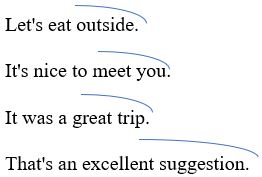
Examples are in this video from Clear English Corner. Watch the video and also listen for:
- Questions
- Rising Intonation in Statements to Make Questions
- Non-Final Intonation
Review these key aspects of intonation in English as you scroll through the rest of this page.
Questions
Intonation for simple questions is more complex because there are different types of questions such as Yes/No questions, wh-questions, and either/or questions.
Rising Intonation in YES/NO Questions
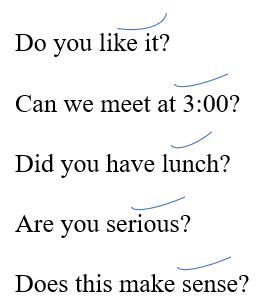
Falling Intonation in wh-Questions
Basic intonation in wh-questions falls at the end like statements.
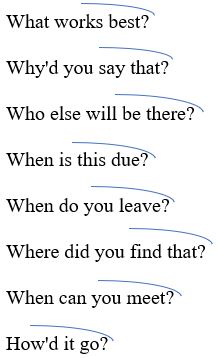
Rising Intonation in wh-Questions
To request clarification or repetition or even express shock, the speaker will ask the wh-question with rising intonation. These questions in the video are asked with rising intonation. The added meaning is given in the first two examples, but clarification, repetition or shock could be interpreted in any of the questions.
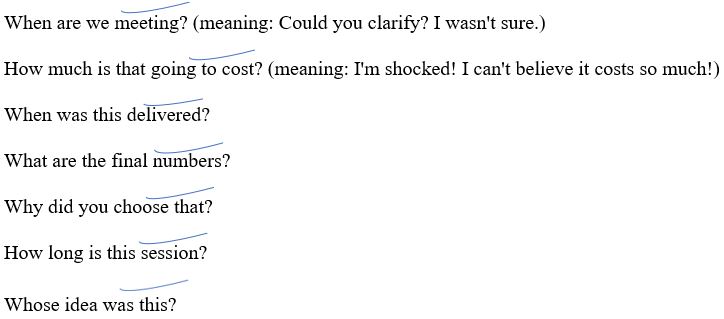
Rising Intonation in Statements to Make Questions
Intonation can be used to turn a statement into a question. Simply use rising intonation at the end of the sentence. Because the intonation pattern is not typical for statements, extra meaning is added with the rise in melody. Often the added meaning is uncertainty, disbelief, shock, or even contradiction.
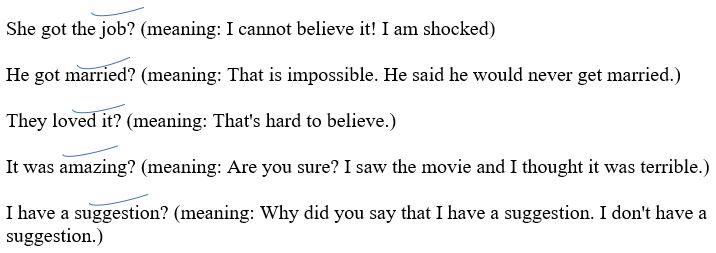
Non-Final Intonation: Rising-Falling Intonation:
A rise in intonation can signal that the speaker is not finished yet. Falling intonation signals the end of the thought. This rise-fall intonation pattern can be found in the middle of longer sentences. The rise in the middle lets the listener know that the sentence has not yet ended.
The rise-fall melody is also used in longer sentences such as compound and complex sentences.
A rise in pitch is the pronunciation equivalent to a comma in writing. The word before the comma can be pronounced with a higher pitch to let the listener know there is more information in the sentence.
Consider these examples from the video Clear English Corner.
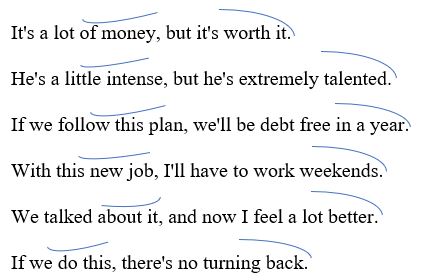
Either/Or Questions
Either/or questions use the rising intonation for the first part of the question and a falling intonation to end the question. In the Clear English Corner, we can hear rising begins on the first part of the either/or question and falling intonation at the end.
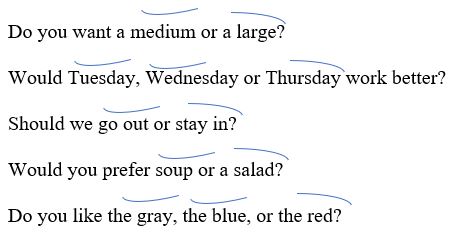
Lists
When saying a list, use rising intonation on all items in the list except for the last item. Use falling intonation on the last item. This lets the listeners know the list has come to an end.
![]()

